|
FAQs on Marine Algae and Their Control 12
Related Articles: Avoiding Algae Problems in Marine System,
Algae
Control, Marine Maintenance,
Marine Scavengers, Snails, Hermit
Crabs, Mithrax/Emerald
Green Crabs, Sea Urchins, Blennies, Algae
Filters, Ctenochaetus/Bristle Mouth
Tangs, Zebrasoma/Sailfin Tangs,
Skimmers, Skimmer Selection, Marine Algae, Coralline Algae, Green Algae, Brown
Algae, Blue-Green
"Algae"/(Cyanobacteria), Diatoms, Brown
Algae,
Related FAQs: Marine
Algae Control FAQs 1, Marine Algae
Control 2, Marine Algae Control
3, Marine Algae Control 4,
Marine Algae Control 5, Marine Algae Control 6, Marine Algae Control 7, Marine Algae Control 8, Marine Algae Control 9, Marine Algae Control 10, Marine Algae Control 11, Marine Algae Control 13, Marine Algae Control 14, Marine Algae Control 15
SW Algae Control 16, SW Algae Control 17,
SW Algae
Control 19, SW Algae Control 20,
SW Algae Control 21, &
Marine Algicide Use, Nutrient Limitation, Marine Algae Eaters, Culturing Macro-Algae; Controlling: BGA/Cyano, Red/Encrusting Algae, Green Algae, Brown/Diatom Algae, Phosphate,
|
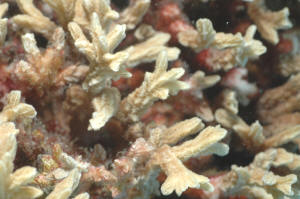 Having other nutrient
using, photosynthetic life present helps... Genus
Hydnophora
Having other nutrient
using, photosynthetic life present helps... Genus
Hydnophora
|
 |
New Print and
eBook on Amazon
Marine Aquarium Algae Control
by Robert (Bob) Fenner
|
Aquarium Cleaning Magnets...Which Ones Are Safe To
Leave In The Tank? -- 08/03/07 I have been looking into magnetic
cleaners for cleaning everyday tank build up. <<Wonderful
devices>> Of course I checked with/through your wonderful web
pages first. <<And...?>> A little concern.
<<Oh?>> You mentioned in one of the FAQ's that there
are some magnets that shouldn't be taken out. ". . .Most
aquarium magnets are safe for leaving in a system... but not all. I
would pull these out when not in use... Please have your brother
contact us re water chemistry checking, use of Polyfilter... as moves
to correct the situation. Bob Fenner>" I have felt to use it
every day or at least every other, it would be more convenient to leave
it in. <<Indeed, and there are some brands that are very
safe/designed for such use...is what I use. Please take a look at the
'Algae Free' and 'Magnavore' brands. I have a pair of
Algae Free Tiger Shark Float magnets that have been in my tank for
'years'>> Somewhere else it was mentioned that not all
magnets are made out of steel. <<Tis true>> So steel
magnets are not good right? Or wrong? <<Steel magnets can be fine
as long as they are 'sealed' from exposure to the water. Keep
in mind that virtually all 'submersible' pumps contain
metals>> Can you please tell me what to look for as far as what
they are made of, or maybe even brands that you know of that are good
or which are hazardous to the corals? <<Any of the cleaning
magnets from the two brands mentioned will serve well. They are a
little pricier than most others, but... There are other brands that
are/can be safe as well, but these two brands are the best in all
aspects, in my opinion>> Thank you as always for your never
ending help. Trisha <<Always a pleasure to assist.
EricR>>
Dinoflagellates/tank breakdown --
07/25/07 Good afternoon, <Hey!> I've been checking around
your website (again) and can't seem to find the right answer I
need. I'm currently breaking down my tank due to an outbreak of
what I think may be a dinoflagellate outbreak. It formed a smothering
layer of light brown slimy looking goo over everything-rock coral,
equipment. I've had an ongoing problem with some hair algae when
bam (sorry Emeril), this stuff took over. Due to the hair algae
problem, I decided to break down the tank. Finally to my questions.
I've removed and scrubbed the live rock that had no
coral/polyps/etc still attached and have started to recure it-is it
feasible that it will still be 'live' after all that has
happened? <Did you let the rocks dry out? If they stayed wet you
should have kept most of the bacteria that is in the "live"
rock. Truthfully, even if it did dry somewhat out it still probably has
the majority of the bacteria unless it was left out for a sustained
period of time.> The sand substrate has a hard 'crust' where
the slim has grown-is it worth trying to save some of the lower levels
or start over with fresh? <You should be able to save all of it. If
you can stir the top and suck the nasty stuff out. But your tank will
look sorta icky.> I still have a few pieces left in the tank that
are 1/4 to 2/3 covered with green star polyps and 1 with a toadstool
that still has the slim/goo on them, but they continue to extend
themselves daily-any ideas as to how to clean them up and isolate them
to ensure the goo is gone? <Personally, I use a turkey baster and
blast all that stuff off of them.> Last, any recommendations as to
considering a total teardown to a bare tank is needed I hope not)? Any
suggestions would be greatly appreciated-Steve. <Steve, I would not
tear the tank down unless I absolutely had to but you do need to get it
cleaned out. I personally use a turkey baster to suck stuff out, stir
stuff up and blast the rocks off that need to be blasted. I have worked
on peoples tanks where I have actually pulled every rock out and
scrubbed them off with a never used toothbrush to clean all the cracks
and crevices off. One thing to note is that you should maybe consider
getting some more current in your tank because I have found that with
more movement in the tank, especially the lower levels you don't
get the hair algae or the Dinos nearly as bad. A couple of basics here.
Something is feeding the bad stuff so you might watch and cut down on
your levels of feeding. You might also want to look some more in the
WetWebMedia base for information about Calcium and alkalinity and its
effects on Dinos. Good luck, MacL>
| Algae, SW, poor English, not just using WWM
- 7/23/07 hello <Your English...> wet web crew. thanks
for the many helpful articles. I attached this picture of my tank.
I have some brown algae that I assume is Cyanobacteria, but i am
not sure. please verify for me if you can. i scraped the gravel
around yesterday, but you can see it on some of the substrate and
on the live rock. if i turn the gravel over it comes back the very
next day. here are some specifics. FOWLR ph 8.4 nitrate 0 nitrite 0
ammonia 0 dKH 8 calcium 430 phosphate 0 i have a cascade 1200
canister filter cleaned regularly. Coralife power compacts 2x65. 2
actinic. aqua c remora skimmer. please help. <Please...
don't write to us until you proof your message/run it through
spelling and grammar checkers... Your system IS indeed out of
balance, you DO have BGA... and you DID NOT have to write us to
find what you need to know already archived on the site: READ here:
http://wetwebmedia.com/marine/maintenance/index.htm SCROLL down to
the green tray on Algae. RMF> |
|
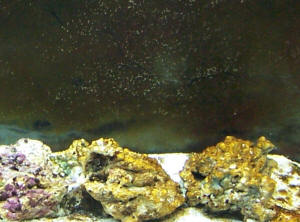
|
| Re: Brown Algae Issues. The Brown Algae
Blues (Cont'd.) -- 07/18/07 Thanks for the response.
<You're welcome!> I went and bought the test kits, and no
signs of fuel for the algae blooms. <A good start, and a good
investment...I assume that means that you have negligible
phosphate, nitrate, a high pH and high alkalinity, right?> As
far as food goes, we only feed flake food, and a quantity that can
be consumed immediately once a day. Unfortunately, I don't have
a sump filtration system, everything is hang on. I have a AquaC
Remora skimmer, Millennium 2000 hang-on filter, and 3 power heads
in the tank. Would changing 75% of the water help any? <Water
changes with quality source water are always good. However, these
kinds of problems should be corrected with consistency over time.
Regular, modest water changes will do the trick. No need for
sudden, massive moves. Get on a water change schedule that you can
handle and stay with it. Try also to increase the flow in your
system to increase oxygenation and maintain a high, stable pH.>
Also, I've added 3 pictures showing you what I was describing,
in case the verbiage I used wasn't adequate. This was 3 days
after a cleaning. Jim <Well, Jim- I really think that you're
on the right track. Continued good husbandry (especially the water
changes and replacing/cleaning your mechanical filtration media
regularly), time and your patience will do the trick. Remember the
other things that we touched on in our previous correspondence, and
stay at it! You can do it! Regards, Scott F.> |
|
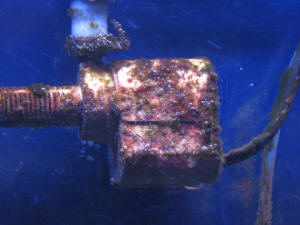 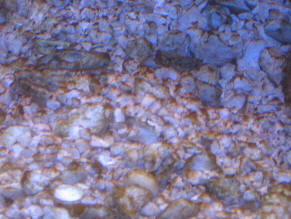
|
Hair algae help 7/13/07 Hi Crew, I
have been trying to get rid of my incessant hair algae for months...
help! Here's my info: 90g + 30g sump, ~500gph return, ~1500gph
closed loop on a 7 outlet manifold, 20000K MH lights. I have 10 small
community fish: 5 blue-green Chromises, two ocellaris, one hogfish, one
purple Pseudochromis, one lawnmower blenny. Bunch of soft corals and
LPS, as well. I change water with TM salt every 1-2 weeks, 5-10 gal.
<Bigger water changes might help. Try 10-20g every two weeks for
awhile.> My relevant parameters: Sal 1.0245 pH 8.2 KH 9.8 NO3 0mg/L
Ca 400ppm PO4 0mg/L Mg 1195 mg/L Any suggestions would be helpful. I
keep siphoning this stuff out, and it keeps growing and growing. <If
you don't have a protein skimmer, I'd suggest getting one (that
and doing bigger water changes). In the mean time, if it's growing
on the glass you can scrap it off with a razor. If you're looking
for a fish to eat it, one of the Bristletooth tangs might do the trick.
However, once it eats all the algae in your tank, you'll have to
take care to feed it well. They need a lot of algae and vegetable
matter to survive.> Thanks, Jason <De nada, Sara M.>
|
Algae Issues - Need Help! -- 07/08/07 Hello
WetWebMedia Crew, <Hello Suresh, Mich here.> I have a 90G
Reef Tank. My setup as below: 90G Reef 440W VHO Phosban Reactor
Protein Skimmer Live Stock 2 yellow wrasse 1 yellow tang 1 purple
tang 1 maroon clown 1 scooter blenny 1 skunk cleaner shrimp 1
copperband butterfly 1 PJ cardinal <I hope this is your final
stocking plan.> Tank Parameters are as below. Temp - 77
degrees 0 - ammonia 0 - nitrate/nitrite 0 - phosphate <Very
good.> I use following chemicals regularly B-Ionic Calcium and
Alkalinity - 30ml Reef Iodide - 10ml every other day. <Do you
test your levels? You should...> DT - twice a week <OK.>
Recently I had an outbreak of following algae in my tank. It is
taking over my rocks. I am not sure if it is diatom or hair
algae. It looks brown but like thick hair??. <Many
possibilities.> I have included some pictures too. <I sort
of see.> Could you kindly help me identify this algae and
especially to address this issue please? <I'm sorry but I
cannot ID the algae from the provided photos. I can help you
hopefully address the issue. You may want to consider adding a
refugium and macro algae, increasing the frequency/volume of you
water changes, Hopefully you are using RO/DI water. Would be wise
to check your source water for TDS. More here and related links
in blue: http://www.wetwebmedia.com/nutrientcontrol.htm
http://www.wetwebmedia.com/refugium.htm
http://www.wetwebmedia.com/maralgae.htm > Thank you so much.
<You are most welcome! Mich>
Regards,
Suresh
|
|
.JPG)
|
Algae Issues - Need Help!
7/8/07 Recently I had an outbreak of following algae in my
tank. It is taking over my rocks. I am not sure if it is diatom or
hair algae. It looks brown but like thick bush of hair?? <The
pictures are really blurry, but I think it's some kind of hair
algae. It might be collecting sediment or growing other types of
algae and/or cyano/diatoms on it too. But again, I can't make
out much of anything in the photos. In any case, you'll want to
lower your nutrients somehow. Do you run a protein skimmer? How
often do you do water changes? More skimming and more frequent
water changes should help. If you're looking for stuff that
eats this, I've seen emerald crabs eat a variety of different
kinds of filamentous algae. But there's no guarantee
they'll eat what you have or eat most of it.> I have
included some pictures too. Could you kindly help me address this
issue please? <I don't have quite enough information about
your tank to give you really specific advice. All I can tell you is
that these types of algae problems are brought on by an excess of
nutrients. You can battle this a number of ways; with skimming,
siphoning of debris, water changes, etc.> Thank you so much.
Regards,
Suresh
<De nada and good luck :-)
Sara M.> |
|
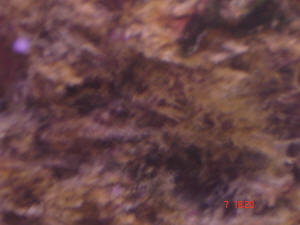
|
Bubbles... Tiny Bubbles, Nuisance Algae, Make Me
Unhappy 7/8/07 Hello WetWeb, <Hi Mike, Mich here.>
I have not been able to figure out what problem I have. <Looks
like excess nutrients to me!> There is some algae growing on my
live rock which I thought was Cyanobacteria but I'm
second-guessing this. I don't think Cyanobacteria has tiny
bubbles that grow on top if it. <It can, but could also be
Diatoms or Dinoflagellates....some of the largest oxygen producers
on the planet!> I'm sure it's not Ventricaria
ventricosa. <You are correct here.> These bubbles grow very
quickly after I remove them (2days) and they seem to constantly
become loose and float the surface. I'm going crazy trying to
figure out what this is. <The bubbles are likely O2.> I will
attach some very crappy pictures but it's the best I can do
with this camera. <Hee! Your description, not mine... but I
won't argue! Perhaps check for a macro setting (The symbol
usually looks like a flower.) on your camera for future close up
shots.> Let me know what other info you need and I will try my
best to provide it. <You should check you nitrates, phosphates
and silicate levels in your tank. There is likely an excess of
nutrients. You may also want to check the TDS of your source water,
which is hopefully RO/DI. May also want to consider a refugium with
Macro algae if you don't already have one. More here and
related links in blue:
http://www.wetwebmedia.com/nutrientcontrol.htm
http://www.wetwebmedia.com/refugium.htm
http://www.wetwebmedia.com/maralgae.htm > Thanks for the
help
<Welcome!>
Mike |
|
.JPG)
|
Algae Issues - Need Help! -- 07/07/07
Hellow WetWebMedia Crew, I have a 90G Reef Tank. My setup as below. 90G
Reef 440W VHO Phosban Reactor Protein Skimmer Live Stock 2 yellow
wrasse 1 yellow tang 1 purple tang 1 maroon clown 1 scooter blenny 1
skunk cleaner shrimp 1 copperband butterfly 1 PJ cardinal I use
following chemicals regularly B-Ionic Calcium and Alkalinity - 30ml
Reef Iodide - 10ml every other day. <no need to add the iodide>
Recently I had an outbreak of following algae in my tank. It is taking
over my rocks. I am not sure if it is diatom or hair algae. It looks
brown but like thick bush of hair??. I have included some pictures too.
<Would you kindly try sending the pictures again? We didn't get
any attachments with this email. Thank you. Sara M.> Could you
kindly help me address this issue please? Thank you so much. Regards,
Suresh
Phormidium... BGA et al. "algal"
woes 7/7/07 Dear Crew, Without going into a lot of tank
details, I'm perplexed with algae (as is everyone). I think
I've gotten hair algae under control. Now I believe I have
Phormidium growing. I consulted J. Sprung's Algae, to read that
this will take over in nutrient poor water and that Derbesia and
Phormidium have inverse relationships. How do you arrive at the happy
medium? Jeff <Mmm... either through nutrient limitation... though
very hard to do with such established, or in settings with established
BGA/Cyanobacteria and Greens as these... OR through prevention,
competition... some possible predation... Please read here:
http://www.wetwebmedia.com/marine/maintenance/index.htm Peruse the
bright yellow tray (N2 wastes)... and the lower dark green Algae ones
contents. Bob Fenner>
Nutrient Control= Algae Control - 06/27/07 Hi
There, <Hey! Scott F. in tonight!> Love your site. I've been
using it since I've started my 46 gallon marine aquarium 3 years
ago. I searched all the algae related issues, but I didn't see
situations that I considered the same as mine. I perform a 10% water
change every week and haven't changed my regimen since I've
owned it. <I love it when hobbyists get habitual about water
changes- great practice!> However, for the past 3 months, I've
had this terrible brown algae problem. It is extremely hair-like in
nature, which isn't unusual according to the articles I've
read. The part that gets me is that the day after I perform a tank
cleaning, the hair algae is growing back quickly. To get rid of it, I
scrub off any surfaces that possess it, including the 8 lb live rock
that I have in there. Some of the artificial pieces are bleached each
week to remove all the growth. By the time the week ends, my tank is
completely brown again and the hair algae is about 1/4" in length.
<Ahh, relatively common, yet exasperating problem.> About 4
months ago, I changed my light fixture to a dual fixture equipped with
a marine Glo bulb to go along with the Aqua Glo bulb. All the pink
growth that I had turned white (from what I could gather it was related
to light shock), and it's finally starting to turn pink again. How
do I stop the algae? Should I be testing for something else? <Well,
the key to control of virtually any algae is nutrient control. There
are a lot of things that you can do, as we'll see in a minute. I
would also test for substances like phosphate or silicate, both of
which are major contributors to nuisance algae blooms.> I only have
a Clownfish, Royal Gramma, and Cleaner Shrimp in there. My numbers
I've tested for are nitrate - 0, ammonia - 0, ph - 8.0, and nitrite
- 0. And my water temp is 80 degrees. Any ideas? Jim <Well, Jim,
there are lots of possibilities. The water parameters that you mention
seem good, but there is something in there that is fueling these
blooms. Likely suspects are the aforementioned phosphates and
silicates. Start by investigating your source water. Most tap water
sources do contain phosphates, and in some instances, silicates. If you
don't already- utilize a reverse osmosis/deionization system to
purify your tap water before you mix it with salt. Remember, if your
source water contains these "algae fuels", every time you
faithfully execute your water changes, you're re-fueling the
nuisance algae bloom. Next, do utilize some form of chemical filtration
media in your system, such as activated carbon, Poly Filter, or the
like, and replace it regularly. Also, be sure to feed carefully, not
allowing excesses of food, or packing juices from frozen foods to enter
the tank...These juices are absolute "rocket fuel" for algae
blooms. Carefully rinse food before feeding, and feed without letting
these juices enter the display aquarium. Another thought would be to
grow and harvest some "competitive" macroalgae, such as
Chaetomorpha, in your system's sump, which will help compete
against the nuisance algae for available nutrients. Maintain a steady,
high pH and consistent alkalinity. Keep water movement vigorous within
the aquarium. Attention to these details, along with your continued
good husbandry habits, will ensure that you'll defeat this nuisance
algae invasion. Good luck in your fight! Regards, Scott F.>
 |
New Print and
eBook on Amazon
Marine Aquarium Algae Control
by Robert (Bob) Fenner
|
|
|

